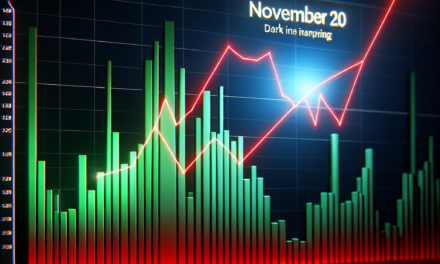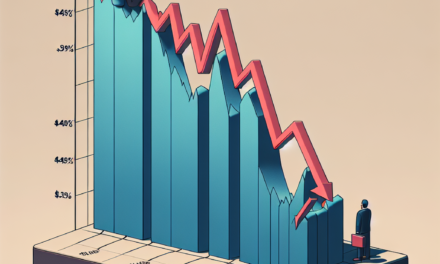“Unprecedented Gains: S&P 500 Soars to New Heights Post-Election Day”
Introduction
Following the recent U.S. presidential election, the S&P 500 experienced a historic surge, marking one of the most significant post-Election Day rallies in its history. This remarkable upswing reflects investor optimism and market confidence in the political transition and anticipated economic policies. The surge was driven by a combination of factors, including expectations of fiscal stimulus, potential regulatory changes, and a general sense of stability following the election outcome. As investors recalibrated their portfolios in response to the new political landscape, the S&P 500’s performance underscored the market’s resilience and adaptability in the face of political shifts. This market recap delves into the key drivers behind the surge, the sectors that led the rally, and the broader implications for the financial markets moving forward.
Analysis Of The S&P 500’s Post-Election Day Surge
The S&P 500, a benchmark index that tracks the performance of 500 of the largest companies listed on stock exchanges in the United States, experienced a historic surge following the recent election day. This remarkable rally has captured the attention of investors and analysts alike, prompting a closer examination of the factors contributing to this unprecedented market movement. As we delve into the dynamics behind this surge, it is essential to consider the interplay of political, economic, and psychological elements that have collectively influenced investor sentiment.
In the immediate aftermath of the election, the market’s response was overwhelmingly positive, driven in part by the resolution of political uncertainty. Historically, markets tend to react favorably when election outcomes are clear, as ambiguity can lead to volatility and investor apprehension. The clarity provided by the election results allowed investors to recalibrate their strategies with a renewed sense of confidence. Moreover, the anticipation of potential policy shifts under the new administration further fueled optimism, as investors speculated on the implications for various sectors, including technology, healthcare, and renewable energy.
Economic indicators also played a crucial role in bolstering the S&P 500’s performance. Leading up to the election, several key metrics suggested a resilient economic recovery, despite ongoing challenges posed by the global pandemic. Employment figures showed signs of improvement, consumer spending remained robust, and corporate earnings reports exceeded expectations in many cases. These positive indicators provided a solid foundation for the market’s upward trajectory, reinforcing the belief that the economy was on a path to sustained growth.
In addition to these tangible factors, psychological elements cannot be overlooked when analyzing the market’s behavior. The concept of investor sentiment, often driven by emotions and perceptions, significantly impacts market movements. In this instance, the election results may have alleviated some of the anxiety that had been building among investors, leading to a surge in buying activity. The so-called “relief rally” phenomenon is not uncommon in such scenarios, where the removal of uncertainty triggers a wave of optimism and risk-taking.
Furthermore, the role of monetary policy in shaping market dynamics cannot be understated. The Federal Reserve’s commitment to maintaining accommodative monetary conditions has been a critical factor in supporting asset prices. Low interest rates and ongoing quantitative easing measures have provided a favorable environment for equities, encouraging investors to seek higher returns in the stock market. This backdrop of supportive monetary policy has undoubtedly contributed to the S&P 500’s impressive post-election performance.
As we consider the broader implications of this historic surge, it is important to recognize that market movements are inherently complex and multifaceted. While the election results served as a catalyst for the recent rally, a confluence of factors, including economic indicators, investor sentiment, and monetary policy, have collectively shaped the market’s trajectory. Looking ahead, investors will continue to monitor developments on multiple fronts, including potential policy changes, economic data releases, and global events, all of which have the potential to influence market dynamics.
In conclusion, the S&P 500’s historic post-election day surge underscores the intricate interplay of political, economic, and psychological factors that drive market behavior. As investors navigate this evolving landscape, a comprehensive understanding of these dynamics will be essential in making informed decisions and capitalizing on opportunities in the ever-changing financial markets.
Factors Driving The Historic Rise In The S&P 500
The S&P 500 recently experienced a historic surge following Election Day, marking one of the most significant post-election rallies in the index’s history. This remarkable rise can be attributed to a confluence of factors that have collectively bolstered investor confidence and driven market momentum. Understanding these factors provides insight into the dynamics that have propelled the S&P 500 to new heights.
Firstly, the resolution of electoral uncertainty played a pivotal role in the market’s upward trajectory. Leading up to the election, investors were cautious, wary of potential volatility and policy shifts that could arise from the electoral outcome. However, once the results were clear, a sense of stability returned, alleviating concerns about prolonged political gridlock. This newfound clarity allowed investors to refocus on market fundamentals and economic indicators, fostering a more optimistic outlook.
In addition to political clarity, the economic recovery from the pandemic-induced downturn has been a significant driver of the S&P 500’s rise. As vaccination rates increased and restrictions eased, economic activity rebounded, leading to improved corporate earnings and stronger economic data. Companies across various sectors reported robust earnings, surpassing analysts’ expectations and reinforcing confidence in the market’s resilience. This positive earnings season has been instrumental in sustaining the rally, as investors anticipate continued growth and profitability.
Moreover, accommodative monetary policy has provided a supportive backdrop for the market’s ascent. The Federal Reserve’s commitment to maintaining low interest rates and its ongoing asset purchase programs have injected liquidity into the financial system, encouraging investment in equities. This environment of easy monetary policy has made stocks more attractive relative to other asset classes, driving demand and pushing the S&P 500 higher. Furthermore, the Fed’s assurances of continued support have mitigated fears of abrupt policy changes, further stabilizing investor sentiment.
Another factor contributing to the historic rise is the increased participation of retail investors in the stock market. The democratization of trading platforms and the proliferation of financial information have empowered individual investors to engage more actively in the market. This surge in retail trading activity has added a new dimension to market dynamics, amplifying price movements and contributing to the overall momentum. The collective influence of retail investors has been particularly evident in sectors such as technology and consumer discretionary, where enthusiasm for growth stocks has been pronounced.
Additionally, global economic conditions have played a role in the S&P 500’s ascent. As major economies around the world recover from the pandemic, international demand for U.S. goods and services has increased, benefiting American companies with global exposure. This global economic recovery has provided a tailwind for the S&P 500, as multinational corporations capitalize on expanding markets and favorable trade conditions.
In conclusion, the historic post-election surge in the S&P 500 can be attributed to a combination of political clarity, economic recovery, accommodative monetary policy, increased retail investor participation, and favorable global economic conditions. These factors have collectively fostered an environment of optimism and confidence, propelling the index to unprecedented levels. As the market continues to navigate these dynamics, investors remain watchful of potential challenges and opportunities that may shape the future trajectory of the S&P 500.
Impact Of Political Stability On The S&P 500
The S&P 500, a benchmark index representing the performance of 500 leading publicly traded companies in the United States, recently experienced a historic surge following the conclusion of the latest election cycle. This remarkable upswing underscores the profound impact that political stability can have on financial markets. Investors, who often seek certainty and predictability, responded positively to the election results, which provided a clearer picture of the political landscape and policy direction for the coming years. As a result, the S&P 500 recorded one of its most significant post-election day gains in history, reflecting renewed investor confidence and optimism.
Political stability plays a crucial role in shaping market dynamics, as it directly influences economic policies, regulatory frameworks, and international relations. When the political environment is stable, businesses and investors can make more informed decisions, reducing the level of uncertainty that often plagues financial markets. In this context, the recent election results were perceived as a stabilizing force, alleviating concerns about potential policy shifts that could disrupt economic growth. Consequently, the S&P 500’s surge can be attributed to the market’s anticipation of a more predictable and business-friendly environment.
Moreover, the election outcome has implications for fiscal and monetary policies, which are critical determinants of market performance. A stable political climate is likely to facilitate the implementation of policies aimed at stimulating economic growth, such as infrastructure spending, tax reforms, and support for key industries. These measures can boost corporate earnings and, in turn, drive stock prices higher. Additionally, political stability can enhance the effectiveness of monetary policy by providing a conducive environment for central banks to implement measures that support economic expansion. The S&P 500’s recent rally reflects investor expectations that such policies will be forthcoming, further bolstering market sentiment.
In addition to domestic factors, political stability also affects international relations and trade policies, which are vital components of the global economic landscape. A stable political environment can lead to more predictable trade policies, reducing the risk of trade disputes and fostering stronger economic ties with other nations. This, in turn, can benefit multinational corporations that are part of the S&P 500, as they rely on global markets for a significant portion of their revenues. The recent surge in the index suggests that investors are optimistic about the prospects for international trade and cooperation, which could support sustained economic growth.
Furthermore, political stability can influence investor behavior by reducing the perceived risk associated with equity investments. When the political climate is uncertain, investors may seek refuge in safer assets, such as bonds or gold, leading to a decline in stock prices. Conversely, a stable political environment can encourage investors to allocate more capital to equities, driving up demand and pushing stock prices higher. The historic post-election day surge in the S&P 500 is indicative of a shift in investor sentiment, as market participants appear more willing to embrace risk in light of the newfound political stability.
In conclusion, the S&P 500’s historic post-election day surge highlights the significant impact that political stability can have on financial markets. By providing a clearer outlook for economic policies, international relations, and investor behavior, a stable political environment can foster confidence and optimism among market participants. As the dust settles from the recent election cycle, the S&P 500’s performance serves as a testament to the importance of political stability in shaping market dynamics and driving economic growth.
Sector Performance In The S&P 500 During The Surge
Following the historic post-election day surge in the S&P 500, investors and analysts alike have been keenly observing the performance of various sectors within the index. This surge, which marked a significant uptick in market confidence, has been characterized by notable movements across different industries. As we delve into the sector performance during this period, it becomes evident that the market’s response was not uniform, with some sectors outperforming others significantly.
To begin with, the technology sector emerged as a clear leader during the surge. This sector, which has been a consistent driver of growth in the S&P 500, continued to attract investor interest due to its resilience and potential for innovation. Companies within this sector, particularly those involved in cloud computing, artificial intelligence, and cybersecurity, saw substantial gains. The increased reliance on digital solutions and remote work technologies has further bolstered investor confidence in tech stocks, making them a cornerstone of the post-election rally.
In contrast, the energy sector experienced a more mixed performance. While there was a general uptick in energy stocks, driven by a rebound in oil prices and optimism about future economic growth, the sector’s gains were tempered by ongoing concerns about sustainability and regulatory changes. The transition towards renewable energy sources continues to pose challenges for traditional oil and gas companies, which are under pressure to adapt to a rapidly changing landscape. Nevertheless, some energy firms that have embraced diversification into cleaner energy alternatives managed to capture investor interest, reflecting a nuanced response within the sector.
Meanwhile, the financial sector also saw a notable boost during the surge. Banks and financial institutions benefited from the prospect of a more favorable regulatory environment and expectations of rising interest rates, which could enhance their profitability. The anticipation of increased economic activity and consumer spending further contributed to the positive sentiment surrounding financial stocks. However, it is important to note that the sector’s performance was not uniform, with some institutions better positioned to capitalize on these trends than others.
The healthcare sector, on the other hand, demonstrated a steady performance, buoyed by ongoing advancements in medical technology and pharmaceuticals. The sector’s resilience can be attributed to its essential nature and the continuous demand for healthcare services, irrespective of broader economic conditions. Additionally, the focus on vaccine development and distribution, as well as innovations in biotechnology, provided further impetus for growth within this sector.
Consumer discretionary stocks also experienced a surge, driven by optimism about increased consumer spending and economic recovery. Retailers, in particular, benefited from the anticipation of a robust holiday shopping season and pent-up demand. However, the sector’s performance was somewhat uneven, with companies that have successfully integrated e-commerce and digital strategies outperforming those that rely heavily on brick-and-mortar operations.
In summary, the post-election day surge in the S&P 500 highlighted the diverse responses of different sectors to changing market dynamics. While technology and financials led the charge, other sectors like energy and consumer discretionary showed varied performances based on their adaptability to new trends and challenges. As investors continue to navigate this evolving landscape, understanding the nuances of sector performance will be crucial in making informed investment decisions. This period of market activity underscores the importance of sectoral analysis in comprehending the broader implications of economic and political developments on the S&P 500.
Investor Sentiment And The S&P 500’s Record Gains
The S&P 500 recently experienced a historic surge following the latest election day, marking a significant moment in the financial markets. This remarkable performance can be attributed to a confluence of factors that have bolstered investor sentiment, leading to unprecedented gains. As investors digest the implications of the election results, the market’s response underscores the complex interplay between political developments and economic expectations.
In the immediate aftermath of the election, the S&P 500 soared to new heights, reflecting a wave of optimism among investors. This surge can be largely attributed to the clarity provided by the election outcome, which alleviated some of the uncertainties that had been weighing on the market. Investors often react positively to reduced uncertainty, as it allows for more accurate forecasting and strategic planning. Consequently, the resolution of electoral ambiguity has been a key driver of the recent market rally.
Moreover, the election results have sparked renewed confidence in the potential for favorable economic policies. Investors are particularly attuned to the prospects of fiscal stimulus, regulatory changes, and tax policies that could emerge from the new political landscape. The anticipation of such policies has fueled expectations of economic growth, thereby enhancing investor sentiment. This optimism is further supported by the belief that a stable political environment will facilitate the implementation of measures aimed at bolstering economic recovery.
In addition to political factors, the S&P 500’s record gains can also be attributed to broader economic indicators that have been trending positively. Recent data on employment, consumer spending, and corporate earnings have painted a picture of resilience in the face of ongoing challenges. These indicators suggest that the economy is on a path to recovery, which has reinforced investor confidence. As a result, market participants have been more willing to invest in equities, driving up stock prices and contributing to the index’s historic performance.
Furthermore, the role of monetary policy cannot be overlooked in this context. The Federal Reserve’s commitment to maintaining accommodative monetary conditions has provided a supportive backdrop for the equity markets. Low interest rates and quantitative easing measures have encouraged investment in riskier assets, such as stocks, as investors seek higher returns in a low-yield environment. This has been a crucial factor in sustaining the upward momentum of the S&P 500.
While the recent surge in the S&P 500 is undoubtedly impressive, it is important to consider the potential risks that could temper this optimism. Geopolitical tensions, inflationary pressures, and the ongoing challenges posed by the global pandemic remain significant concerns. Investors must remain vigilant and adaptable, as these factors could influence market dynamics in the coming months.
In conclusion, the S&P 500’s historic post-election day surge is a testament to the complex interplay of political, economic, and monetary factors that shape investor sentiment. The resolution of electoral uncertainty, coupled with positive economic indicators and supportive monetary policy, has fueled a wave of optimism that has propelled the market to new heights. However, as with any market rally, it is essential for investors to remain cognizant of potential risks and to approach the future with a balanced perspective. As the market continues to evolve, the ability to navigate these dynamics will be crucial for sustaining long-term gains.
Comparing The S&P 500’s Surge To Past Post-Election Trends
The S&P 500’s recent post-election day surge has captured the attention of investors and analysts alike, marking a historic moment in the financial markets. This remarkable rally, which saw the index achieve unprecedented gains, invites a closer examination of how it compares to past post-election trends. Historically, the S&P 500’s performance following presidential elections has been a subject of keen interest, as it often reflects investor sentiment and expectations for the incoming administration’s economic policies. By analyzing these trends, we can gain valuable insights into the factors driving the current surge and its potential implications for the future.
Traditionally, the S&P 500 has exhibited varied behavior in the aftermath of elections, influenced by a multitude of factors including political stability, economic conditions, and market sentiment. For instance, in the wake of the 2008 election, the index experienced a significant downturn, largely attributed to the global financial crisis that was unfolding at the time. Conversely, the 2016 election saw a notable uptick in the S&P 500, driven by investor optimism regarding anticipated tax reforms and deregulation under the new administration. These historical examples underscore the complex interplay between political events and market dynamics.
In comparing the current surge to past trends, it is essential to consider the unique circumstances surrounding this election cycle. The recent rally can be attributed to several key factors, including investor confidence in a stable political transition and expectations of favorable economic policies. Additionally, the broader economic context, characterized by a robust recovery from the pandemic-induced recession, has played a crucial role in bolstering market sentiment. This confluence of factors has created an environment conducive to a strong post-election performance for the S&P 500.
Moreover, the role of monetary policy cannot be overlooked when analyzing the current surge. The Federal Reserve’s commitment to maintaining low interest rates and providing ample liquidity has been a significant driver of market gains. This accommodative stance has not only supported economic recovery but also fueled investor appetite for equities, contributing to the S&P 500’s impressive rally. In this context, the current surge can be seen as part of a broader trend of market resilience in the face of economic challenges.
While the S&P 500’s post-election performance is undoubtedly impressive, it is important to approach these gains with a degree of caution. Historical trends suggest that initial post-election rallies can be followed by periods of volatility, as markets adjust to the realities of new policy implementations and unforeseen economic developments. Therefore, investors should remain vigilant and consider the potential risks associated with such rapid market movements.
In conclusion, the S&P 500’s historic post-election day surge offers a fascinating case study in the interplay between political events and market dynamics. By comparing this rally to past trends, we can better understand the factors driving current market behavior and anticipate potential future developments. As always, a balanced approach that considers both opportunities and risks will be essential for navigating the ever-evolving landscape of the financial markets. This analysis not only highlights the significance of the recent surge but also underscores the importance of historical context in interpreting market trends.
Future Outlook For The S&P 500 After The Historic Surge
The S&P 500’s historic surge following the recent election has captured the attention of investors and analysts alike, prompting a reevaluation of the market’s future trajectory. This unprecedented rally, which saw the index reach new heights, has been fueled by a confluence of factors that have instilled renewed confidence in the market. As we look ahead, it is essential to consider the implications of this surge and what it might mean for the S&P 500’s future performance.
To begin with, the election results have provided a sense of political stability, which is often a key driver of market confidence. Investors tend to favor predictability, and the resolution of electoral uncertainties has alleviated some of the apprehensions that previously weighed on the market. This newfound stability has encouraged investors to re-enter the market, driving up demand for equities and contributing to the S&P 500’s remarkable ascent.
Moreover, the economic policies proposed by the newly elected administration have been met with optimism by market participants. Promises of fiscal stimulus, infrastructure spending, and tax reforms have bolstered expectations for economic growth, which in turn has had a positive impact on corporate earnings projections. As companies anticipate improved financial performance, their stock prices have responded accordingly, further propelling the index upward.
In addition to domestic factors, global economic conditions have also played a role in the S&P 500’s surge. The gradual recovery from the pandemic-induced economic downturn has been gaining momentum, with many countries reporting improved economic indicators. This global recovery has provided a favorable backdrop for U.S. companies, many of which have significant international exposure. As global demand picks up, these companies are likely to benefit, enhancing their profitability and supporting higher stock valuations.
However, while the current outlook appears promising, it is important to acknowledge potential challenges that could impact the S&P 500’s future performance. Inflationary pressures, for instance, remain a concern for investors. Rising prices could lead to higher interest rates, which may dampen economic growth and weigh on corporate profits. Additionally, geopolitical tensions and trade uncertainties continue to pose risks that could disrupt market stability.
Despite these potential headwinds, the overall sentiment remains cautiously optimistic. The Federal Reserve’s accommodative monetary policy stance is expected to persist, providing a supportive environment for equities. Furthermore, technological advancements and innovation continue to drive growth in key sectors, offering opportunities for sustained market expansion.
In conclusion, the S&P 500’s historic post-election surge has set the stage for a potentially prosperous period for the market. While challenges remain, the combination of political stability, favorable economic policies, and a recovering global economy bodes well for the index’s future performance. Investors should remain vigilant, however, as they navigate the evolving landscape, balancing optimism with an awareness of the risks that lie ahead. As the market continues to adapt to changing conditions, the S&P 500’s trajectory will likely reflect the dynamic interplay of these various factors, shaping the future outlook for this benchmark index.
Q&A
1. **What caused the S&P 500 to surge post-Election Day?**
The surge was driven by investor optimism about potential political stability and anticipated economic policies following the election results.
2. **How significant was the S&P 500’s post-Election Day performance?**
The S&P 500 experienced one of its largest single-day gains in history, reflecting strong market confidence.
3. **Which sectors contributed most to the S&P 500’s rise?**
Technology, healthcare, and financial sectors were among the top contributors to the index’s gains.
4. **What role did investor sentiment play in the market surge?**
Positive investor sentiment, fueled by expectations of favorable policy changes and economic recovery, played a crucial role in driving the market upward.
5. **How did the election results impact market volatility?**
The election results initially increased market volatility, but as outcomes became clearer, volatility decreased, leading to a more stable market environment.
6. **Were there any notable stock performances within the S&P 500?**
Several large-cap stocks, particularly in the tech sector, saw significant price increases, contributing to the overall index surge.
7. **What are analysts predicting for the S&P 500 following this surge?**
Analysts are cautiously optimistic, suggesting that while the surge reflects positive sentiment, future market performance will depend on actual policy implementations and economic conditions.
Conclusion
The S&P 500 experienced a historic surge following Election Day, reflecting investor optimism and confidence in the market’s future direction. This post-election rally was driven by a combination of factors, including anticipated policy changes, economic recovery prospects, and a potential resolution to political uncertainties. The surge underscores the market’s resilience and adaptability, highlighting the importance of political events in shaping investor sentiment and market dynamics. Overall, the record-breaking performance of the S&P 500 post-Election Day signifies a pivotal moment in the financial markets, with implications for future economic growth and investment strategies.





